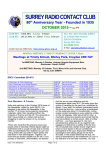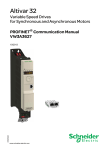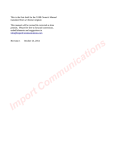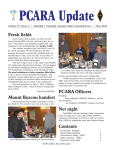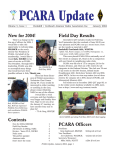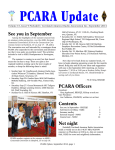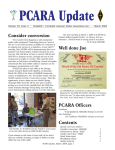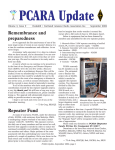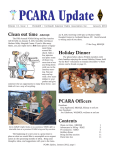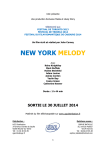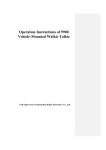Download December 2014
Transcript
PCARA Update Volume 15, Issue 12 Peekskill/Cortlandt Amateur Radio Association Inc. December 2014 Holiday winner This year’s PCARA Annual Holiday Dinner is on December 7, 2014, 5:00 pm at the Cortlandt Colonial Restaurant. The cost is $30.00 per person and soda/alcoholic drinks are extra. The menu can be found in this issue of the PCARA Update, and we will be having selections from Dinner Package #3. Please consider joining us, and as always, all are welcome. Just a reminder, the election of Officers will also take place that evening. in the ENY section, and 11�� out of the 34 entries in ENY. Well done PCARA! A full report courtesy of Malcolm, NM9J can be found in this month’s Update. Finally the event you’ve all been waiting for — the Annual PCARA Bring and Buy Auction to be held at the January 2015 meeting. You have just over a month to go through all your treasures and decide which you’ll bring with you to the meeting so somebody else can go home with them! After the Holiday Dinner, our next regularly scheduled meeting is on Sunday January 4, 2015 at 3:00 pm at Hudson Valley Hospital Center in Cortlandt Manor, NY. - 73 de Greg, KB2CQE PCARA Officers President: Greg Appleyard, KB2CQE, kb2cqe at arrl.net Vice President: Joe Calabrese, WA2MCR; wa2mcr at arrl.net Venue for PCARA’s Holiday Dinner on Sunday December 7 is the Cortlandt Colonial Restaurant in Cortlandt Manor. The new Super Stationmaster for the 449.925 MHz repeater is on order and expected to arrive early in December. We’ll need a work party willing to brave the elements to get it in place. Once installed the antenna should provide for many years of dependable service. If you are interested in helping to install the antenna, just let us know. Once again, a big thank you to all the members who made very generous contributions that helped to make it a reality. The results for Field Day 2014 are in. PCARA did admirably! We were 1�� out of 3 entries in Category 2A Contents Special FM mobile edition Holiday winner - KB2CQE Adventures in DXing - N2KZ Baojie BJ-UV55 - W2CH Imitation Game New lamps for old (Icom) - NM9J Field Day results Antenna season - NM9J Xiegu X-108 review - W2CH Holiday dinner 1 2 4 5 6 9 10 12 13 Net night Peekskill/Cortlandt Amateur Radio Association holds a weekly net on the 146.67 MHz W2NYW repeater on Thursdays at 8:00 p.m. Join net control Karl, N2KZ for news and neighborly information. PCARA Update, December 2014, page 1 Adventures in DXing - N2KZ Remember the words of Polonius? “This above all: to thine own self be true.” After all your holiday shopping, may there be some room for you! If you are looking for a suggestion that will not break your bank account, I may have just the thing for you. Let me introduce you to a friend that travels wherever I go: a Yaesu FT-1900R transceiver. Simple, basic and powerful, it might be all you need as a mobile transceiver for your car. It would be a nice addition to your ham shack, too. Let me get you acquainted... The FT-1900R is a single band FM transceiver for 2 meters. It operates with up to 55 watts and has more features Yaesu FT-1900R single band mobile than you can transceiver. imagine. It comes with an 86 page manual! Like any modern transceiver, it requires a little preparation before use. I began with programming a handful of local repeaters and some common simplex frequencies. After over a year of use, I have not used even half of the 221 memories available. Unless you have a super-human encyclopedic memory, a reference copy of the manual is an essential companion to this rig. Keep a copy with you at all times to provide answers to all of your questions. A Nifty manual is also available at: http://niftyaccessories.com/Yaesu_cards.htm providing another point of view in a concise coil-bound little book. Don’t let the complexity scare you. A few minutes of basic setup will produce a setand-forget transceiver that you won’t have to think about ever again! All the options are just that: Options! Experiment or leave idle – It’s your choice! Early on, I discovered how much power is necessary to produce a full 55 watt signal. I had previously sufficed using a cigarette lighter plug to attain power for my mobile rigs. When I tried operating the FT-1900R simiNifty Mini-Manual. larly wired, I received some interesting signal reports remarking on my weird audio distortions and overall signal clarity. When I backed off the power to 25 watts or less, the signal appeared clean. I constructed a direct connection between the fused power wiring of the rig and my car battery. Suddenly, high power operation was sweet. Operating at 55 watts is an amazing experience. Using a Diamond M285 5⁄8 wavelength whip on my trunk lid, I have enjoyed quite satisfying results. Riding along the New York State Thruway northbound I have been able to comfortably hold some local repeaters almost forever, losing contact only when approaching the southern suburbs of Albany. I can now hear W1AW code practice broadcasts on 147.555 MHz during my commutes home from Stamford and have access to more NOAA all-hazards weather radio stations than ever before. It’s fun having big ears! Physically mounting the FT-1900R required a little thought. I wanted to install it into my M285 Toyota Corolla without drilling, marking or otherwise altering the car’s interior. Although the unit physically fit snugly into the convenience compartments below the car radio, there was not enough air circulation to support it. Transceivers don't usually have a flat back with power, antenna cables and heat sinks to consider. I also wanted to provide a little shock absorption from the bumps and swerves on the road. I had to find another solution. I invented a clever compromise. I attached a scrap piece of wood (11⁄2" � ´ 71⁄4" � ´ 51⁄4" �) cut, beveled and donated free from Home Depot (thanks, guys!) to the provided FT-1900R mounting bracket. The transceiver/wood combo created a hefty and sturdy FT-1900R fixed to wooden block in Karl’s Toyota Corolla. brick that required no permanent mounting and fit perfectly when placed atop the two cup holders built into the Corolla’s center console. The depth of the cup holders provided all the clearance I needed for the antenna and power cables and it was positioned per- PCARA Update, December 2014, page 2 fectly to receive direct air conditioning from the dashboard. My right hand could comfortably manipulate all the rigs controls. Does it get any better than this? Yaesu’s ergonomic design is thoughtful and logical. All the basic controls are where they should be. Volume, squelch and power appear left of the large backlit LCD display. A nice big tuning knob is ready for use on the right. All of the more complicated functions are behind the five soft pushbuttons underneath the display tucked away and ready when you need them. It just makes sense. Even these buttons have dual functions. Touch them briefly for their basic functions (like tuning shortcuts) or hold down the buttons for more advanced functions (like reaching deep menu options.) Yaesu FT-1900R front panel The supplied MH-48 microphone is just as easy to use, putting many of these functions in the palm of your hand. Along with many shortcuts, the microphone provides customizable buttons, direct frequency keypad entry and all the pushbutton features found on the front panel. The mic. can be backlit for nighttime operation and locked to prevent unwanted transmissions and changes. The menu mode is deep and comprehensive offering 59 useful options. Here are a few that I particularly like: Every memorized frequency can have a name (alpha-identiYaesu MH-48 microphone. fier.) You can call a memory whatever you like (e.g. ‘Boston’ or ‘Bad Axe.’) You don't have to memorize what each memory is programmed to do! A DC voltmeter is provided to measure how your car battery or power supply is holding up. You’ll also find a thermometer to measure how hot the rig’s heat sink is at the moment. There are two types of squelching. The ‘classic’ squelch breaks in when a signal rises above a certain level of noise. The RF squelch can be set to break at a preset level of signal (from S1 to S9.) Timers are available to time out a transmission or completely turn off the rig after a fixed idle time. The FT-1900R can also act as a complete weather alert receiver. Receiver cov- erage runs from 136 through 174 MHz including maritime mobile frequencies. The icing on the cake? It also features a powerful CW trainer for those who are learning or honing their Morse Code skills. Bravo! Some unusual features can also be found: You can configure the rig to emit the sound of a bell when a specific analog PL or DCS (digital coded squelch) tone is received. There are endless ways to customize how you scan channels for activity. I like the ‘Programmable Memory Scan’ feature where you can configure your scanning to specific frequency ranges. I built one PMS to cover marine channels from 156.050 through 157.425 MHz so I can hear boat traffic along Long Island Sound. With ‘Smart Search’, you can pick a center frequency and the radio will automatically remember the first 15 frequencies above and below center scanning frequency until they are all filled. You’ll appreciate this the next time you visit a new city! Yaesu owners can also enjoy ARTS ‘Automatic Range Transponder System.’ This is a sophisticated program that will automatically send out digital PL signals to alert friends of your presence on the air and receive ARTS prompts, as well. You’ll always know when a friend is on the air and available to talk and they will know when you are around, too! It runs in the background making connections without effort. ARTS also has a CW identifier to make your automatic polling signals legal every ten minutes. Oh, the things this rig can do! Operation of the FT-1900R has been very impressive. The receiver is very sensitive and resists intermod and noise with grace. I have driven this rig through some prohibitive RF environments with no sign of desensing or bleed-through. A tall tower FM station is near my workplace and I never hear a peep out of it as I drive by while using my FT-1900R daily. Although I do hear some noise once in awhile, the source needs to be quite profound in strength to register with this rig. Receiver audio is great, big and clear. I have never heard a bad word about my transmit audio. It provides good times every day! One thing you should be aware of: If you operate at 55 watts for extended periods of time, the FT-1900R is capable of getting very hot. I chair a weekly net using my FT-1900R. The net might last an hour or more with my rig transmitting at least half of that time. In the summer, I can actually feel the heat coming off the heat sink by the end of the net. The temperature Yaesu FT-1900R has a substantial heat sensor can rise to 150 degrees sink and no built-in fan. PCARA Update, December 2014, page 3 or more. There is no fan. The heat sink rides alone! This is a lot to ask of any rig. My cure is to lower power or pour some air conditioning onto it. Both methods work well. Make sure you have a good match with your antenna. Less reflected power equates to a cooler rig. I can’t imagine a better buy than the Yaesu FT-1900R. Owners take advantage of Yaesu’s years of design development for the ham radios and land mobile radios. They really have this unit figured out! Even if you have no interest in purchasing one, you should download the manual and have a look at all it can do. Find it at: http://www.yaesu.com. Here is a top quality rig at a bargain price. It may be all you ever need in your car. I really enjoy owning one. Baojie BJ-UV55 - W2CH I recently purchased the Baojie BJ-UV55 dual band, 144-440 MHz Chinese-made mobile transceiver through AliExpress, from Alibaba China. The price was $170.00 US plus $31.63 shipping. It arrived here after almost two weeks via the Chinese and US Postal Services. Other prices on the Internet vary from $200.00 to $298.00 at Amazon. Baojie BJ-UV55 dual-band mobile transceiver, programmed by W2CH for the PCARA repeaters. Karl, N2KZ enjoys using his Yaesu FT-1900R mobile transceiver, mounted over the Toyota Corolla cup holders. Happy New Year Please don’t forget the annual on-air tribute to years of amateur radio past: ARRL’s Straight Key Night. For 24 hours, beginning on New Year’s Eve at 7 pm Eastern, hams will be getting on the air and operating CW with nothing more than their fists. Many participants add to the experience by dusting off vintage gear and operating with tubes glowing in their shacks. You’ll hear a lot of very interesting signals that night and New Year’s Day. This event also commemorates my 15th year as a ham. I made my very first QSO on January 1, 2000 using a Heathkit HW-16! Even if you don’t usually operate CW, you will enjoy hearing just what the bands sounded like long ago. Tune in! See you on 80 meters! My very best holiday wishes to one and all! Thanks for another great year on the air! 73 es dit dit de N2KZ ‘The Old Goat.’ The transceiver is unusual because it does not have a built-in speaker, which is instead located on the opposite side of the microphone from the keypad. This loudspeaker still puts out a good volume and there is also a jack on the back of the transceiver for an external speaker. The keys on the front side of the microphone do not program the transceiver, but only allow DTMF tones and a calling sequence to be sent. The microphone is plugged in with an RJ-45 type connector to the front of the transceiver and is moderate in size. The radio also comes with a mobile mounting bracket. Baojie microphone has a There is an adequate built-in loudspeaker. fused power cord, several feet in length and an SO239 plug at the back of the transceiver for the antenna input, alongside the rear-mounted heat sink. I did see a programming cable and CD-ROM mentioned in the advertising, but I did not purchase it, so I manually programmed the memories myself. One has to go through the menu items to set the split, the offset direction, the CTCSS encode/decode tones or DCS code, and then to select the memory, of which there are PCARA Update, December 2014, page 4 128. You must first memorize the receive frequency with appropriate settings to the desired channel number, then set the transmit frequency and store that to memory in the same channel number. Rear view of Baojie BJ-UV55 showing (L to R) the antenna connector, heat-sink, power cord and external speaker connector. As a result, above the left frequency display there will be a, “+” and a “–”, to indicate the repeater offset is stored in memory. The S-meter reading for either display is always above the right frequency digits. The same applies to the transmit power meter which indicates high or low power, 45 watts high VHF, 35 watts high UHF, and about 10 watts low for both bands. The display color is by default set to pink on standby receive, red on transmit, and blue when a signal is received, though it can be varied among all three through menu choices. Close-up of the Baojie BJ-UV55 display. [W2CH pic] The transceiver has a menu item to set the scanning modes, but I have not found out any information in the manual as to how to make the transceiver scan automatically from receive standby. The manual is not always clear in its English translation as to how each function works. I could not understand how to program the transceiver from the manual, but I learned the technique from a video on YouTube. The Baojie receives and transmits between 136-174.995 and 400-470.995 MHz. One major problem I have experienced is that the UHF receiver cuts out after I have been transmitting on UHF or VHF, and does not return until the transmitter has not been used for a while. The UHF transmit also cuts out after a period of use. I have not been able to diagnose these problems yet. Normally the reception, — when working — is good on VHF and UHF, Label on the bottom of the transceiver and transmisindicates the frequency coverage. sion audio reports have been good. So my recommendation is not to buy the Baojie BJ-UV55 transceiver because of quality control issues. - Ray, W2CH Imitation Game A new movie about the life of Alan Turing was released in Britain on November 14. The Imitation Game, starring Benedict Cumberbatch and Keira Knightley, shows how English mathematician and logician, Alan Turing, helped crack the Enigma code during World War II. Your editor already received a positive recommendation from G3LWK in the UK, saying this movie is well worth seeing. The same period of history was covered in the article “Broadsword calling Danny Boy” (October 2014 PCARA Update), where the role of Voluntary Interceptors and the UK’s Radio Security Service was described. In the fall of 2013, as work on the movie began, the Radio Society of Great Britain put out a request for members who had The Imitation Game vintage HRO and AR88 communication receivers. The company making The Imitation Game wanted to borrow authentic models, which were widely used for radio interception during World War II. In the December 2014 issue of RadCom, RSGB reported on a letter they received from the producers, thanking all who had helped with the loan of equipment for the movie. The Imitation Game went on limited release in the USA on November 28. Wider release is expected in late December. PCARA Update, December 2014, page 5 New lamps for old (Icom) I like older VHF/UHF radios that are rugged and easier to operate than modern sets. I am also fond of the Icom brand as their transceivers seem to have a little more quality than their competitors. A few weeks ago, while browsing the outdoor tables at Mount Beacon ARA’s Hamfest, I noticed that one of the sellers had an Icom IC-2710H on offer. The IC-2710H was a dual-band FM transceiver from 1996, with separate controls for each band and a dual-frequency display. The radio is capable of simultaneous reception on VHF/UHF bands as well as VHF/VHF or UHF/UHF. I decided to bring the IC-2710H home with me from Mount Beacon and install it in the radio room. Pining for the fjords My first task was to un-box the radio and carry out an initial check. The first thing I noticed was an overpowering smell of pine oil. Perhaps that’s why the radio had been displayed on an outdoor table. I found the offending article was the 12 volt power lead, which consisted of the usual red and black cables, inline fuses and a twopin polarized connector to fit the radio pig-tail. I tried all ways I could to remove the smell from the power cable, including cleaning with Fantastik, spraying with Febreze Smelly cable from the Icom and leaving in a sealed IC-2710H. container with sodium bicarbonate. None of these methods brought about any improvement — the smell was as bad as ever. I substituted an identical power cable from one of my other radios and sealed the original item inside two Ziploc freezer bags. There is still a slight odor of pineoil lingering around the radio. I have no idea how the original cable became so smelly — perhaps the previous owner was trying to prevent rodents from gnawing on it? If so, I would not recommend use of pine-oil for this particular application. Initial tests After connecting the radio to a 12 volt power supply, I discovered that it did not have the optional UT-104 tone squelch unit installed. This was a bit disappointing as I had asked the vendor whether tone decode was included. (More on this later.) The radio seemed to be working satisfactorily. I made a note of the existing memory channels that had been programmed into memory — they were mostly 146 and 440 MHz repeaters in Putnam, Dutchess, Rockland and Orange Counties. I carried out a full reset to clear the memories, then programmed my own selection of frequencies. I checked the power output and compared sensitivity with another radio — the IC-2710 was behaving satisfactorily. One word of caution — as with most Icom radios, don’t turn the squelch control past 12 o’clock or you will activate the RF attenuator, weakening incoming signals. Missing microphone The microphone included with the radio was an Icom HM-133, which is the same microphone supplied with current Icom mobile radios such as the ID-880H. The correct microphone for an IC-2710H should have been the Icom HM-98, with a plastic cover over the DTMF keypad. Unfortunately this microphone is now obsolete — and from my own experience, I know that HM-98s can have problems with their press-totalk micro switch after heavy use. Fortunately Correct Icom HM-98 microphone (left) the HM-133 with cover in place over the keypad and operates in a HM-133 microphone as supplied (right). similar way to the HM-98, apart from the modified keypad layout and stronger microphone audio. Dim bulb The liquid crystal display for the IC-2710H is backlit with an amber-colored light that can be dimmed. During initial tests, I noted that one of the three lamps was not working, while a second lamp was flickering and failed shortly afterward. Icom IC-2710H VHF/UHF transceiver I downhad only one of its three display lamps loaded a copy of working. the Service PCARA Update, December 2014, page 6 Manual from http://www.radiomanual.info/. There I found that the front panel backlight is provided by three incandescent lamps, Icom part number HRS-77219A-RE. These are tiny “grain-of-wheat” bulbs rated at 12 volt, 60 mA. I had experience with changing similar bulbs on an old IC-3200A (see PCARA Update March 2009) so I knew they were available Grain-of-wheat lamp from Radio Shack, part number 272-1092. Fortunately, I still had a few in stock. There is an exploded diagram in the IC-2710H Service Manual which shows how to disassemble the front panel control unit. The first job is to detach the control unit from the main body. You push the release button on the side of the control unit, then slide the unit to the left and pull it away from the chassis. Exploded diagram shows how to disassemble the control unit. With the control unit face-down on the bench, I could see two Phillips screws securing the back cover. These screws were removed, so the back cover could be lifted away, revealing the control unit circuit board. (This must be the easiest disassembly for changing panel lamps that I can remember!) A color layout of the board is included in the Service Manual, which Control unit for the IC-2710H with back cover removed. indicates the position of the three incandescent lamps DS1, DS2 and DS3. Circuit board layout for the Control Unit (bottom view), showing the three incandescent lamps DS1, DS2, DS3. From the large solder blobs, it looked as though the lamps in my own radio might have been replaced in the past. I used a solder-sucker and a small iron to remove excess solder, then teased out the two burntout bulbs. It was only a few minutes work to solder in two new “grain-of-wheat” lamps, replace the back cover, then restore the front panel control unit to its position at the front of the radio. Control unit after burnt-out lamps DS1 and DS2 had been removed (arrowed), ready for the new lamps. I switched the radio on and was rewarded with a bright, amber light, fully illuminating the display and the backlit push-buttons on the front panel. I adjusted the display dimmer setting from “d-4” (brightest) to “d-1” (dimmest) to prolong life of the bulbs. Programming convenience Back when the IC-2710 was originally marketed, Icom also sold an optional OPC-646 programming cable and CS-2710 programming software. The software is no longer available from Icom but it is listed for download from the Highfields ARC web site, http://highfields-arc.co.uk/constructors/other/icomdosclonesw.htm. This is DOS-based software, needing a special serial cable to connect to the radio. I could not find any modern Windows-based software from RT Systems or anywhere else, so I decided to forgo the computer connection and program my favorite channels manually. Fortunately, programming did not take very long thanks to the design of the IC-2710. There is a com- PCARA Update, December 2014, page 7 plete set of controls for each of the two bands. This includes separate tuning, squelch and volume controls, each of which also acts as a push-button. Combined with the left-side and right-side buttons for selecting VFO, Memory and Memory-write, plus the shared buttons for duplex and tone setting, there is a total of fifteen push-buttons available on the small front panel. They allow easy setting of a VFO frequency followed by repeater offset and PL tone then storing all these parameters in a memory channel. Insertion of UT-104 Tone Squelch Unit into the miniature socket on the main circuit board of the IC-2710H. Icom IC-2710H, now fully illuminated. Front panel has separate controls for VHF left side and UHF on right side. Tone decoder As mentioned earlier, the IC-2710 that I purchased did not include the optional UT-104 Tone Squelch Unit. From past experience, these accessories can be difficult or impossible to find once the radio has gone out of production. (So purchase while you can!) Ever hopeful, I carried out a quick Internet search and found that R&L Electronics actually had the UT-104 Tone Squelch Unit for correct tone-squelch the IC-2710H. unit available on closeout — so I ordered one. It arrived a few days later, and did not take very long to install. All I had to do was switch off, disconnect the power cord then remove the bottom cover from the radio. This cover is held on with a single Phillips screw, but it also needs a flat-blade screwdriver to carefully pry off, using the slots provided. The UT-104 tone squelch unit then fits onto a tiny connector, close to the front of the transceiver. Once the radio was boxed up and reconnected, I checked operation of the tone squelch unit, which was quite satisfactory. Why decode? You might be wondering why I was so enthusiastic about having a tone decoder in the radio. Wasn’t the built-in tone encoder sufficient? The usual reason for needing a sub-audible tone encoder in an FM transceiver is for repeater access, with a suitable tone applied to outgoing transmissions on the repeater’s input frequency. Only when the repeater detects the correct tone on its input is the transmitter keyed on the output frequency. The reason I wanted the optional tone decoder was so I could monitor repeaters where PL-tone encoding is also applied on the repeater’s output frequency. This allows the radio to reject transmissions from any other repeaters with a different PL tone — or with no tone at all. The radio will also reject interference from traffic signals, fiber optic terminals, switch mode power supplies and other sources of electrical noise that show up on the same frequency. You may have noticed this kind of interference on the output of our PCARA 146.670 MHz repeater — it will open a mobile radio’s noise squelch while driving around various parts of Peekskill and Cortlandt. The Icom tone squelch unit mutes the IC-2710H radio until the correct sub-audible tone is received. I have two adjacent memory channels programmed in my radio, one without and one with tone squelch, so it is easy to select this feature when needed. The UT-104 unit also allows the radio to scan for any sub-audible tone frequency encoded on the incoming signal — this can be useful if you do not know the tone of a new repeater or other transmission. The “pocket beep” function which is also available with the UT-104 indicates by “beeping” after a signal has been received with the desired tone. Clean-up Despite initial problems with smelly cables, burntout bulbs and lack of a tone decoder, my IC-2710 is now glowing brightly and smells almost like new. I’m glad I picked it up. - NM9J PCARA Update, December 2014, page 8 Field Day Results Full results from Field Day 2014 have been published in December’s QST and on the ARRL web site. See http://www.arrl.org/results-database?event_id=58360. For 2014, PCARA was back to full strength and our Field Day entry returned from Category 1A to Category 2A, with two HF stations operating simultaneously and the ‘free’ VHF station working 6 meters. PCARA’s score in Class 2A was in-line with provisional results published in the July issue of PCARA Update. See the bold column in the table below. Peekskill/Cortlandt ARA, W2NYW, Class 2A 2002 2003 2004 2005 2007 2008 2009 2011 2012 QSOs: 718 733 968 853 1019 1109 694 879 968 Power 2 (<150W) Partcpts: 15 11 12 10 14 10 10 14 15 Tot scor: 2096 2328 2996 2798 2906 3460 2746 2602 2920 Peekskill/Cortlandt ARA, W2NYW, 2013-2014 2013 (1A) 2014 (2A) QSOs 768 722 Power 2 (<150W) Partcpts 14 16 Tot score: 2040 2460 PCARA President Greg KB2CQE observed at the time that PCARA’s Field Day 2014 was a home run with excellent attendance. The description was appropriate because we were sharing the dugout at Walter Panas High School with several Little League teams. Karl N2KZ operates from the Field Day dugout with George WB9YRR logging. Ken W1YJ is far right, behind the Little League players. Publication of the final results by ARRL allows a comparison with other neighboring groups in the Eastern New York section and the Hudson Division. In Field Day 2014, PCARA was... Ÿ Joint first out of 3 entries in Category 2A, ENY section. Ÿ Joint eleventh out of 34 in all of ENY section. Ÿ Joint sixth out of 11 in Category 2A, Hudson Division. Ÿ Joint 31st out of 97 in the entire Hudson Division. Ÿ Joint 152nd out of 392 for Category 2A nationwide. Ÿ Joint 735th out of 2686 entries total. Those joint honors were all shared with the Happy Hams group, who were using the callsign of Jay, K2DXU. The Happy Hams are a group of operators who get together in Putnam County to participate in Field Day. They scored exactly the same number of points as PCARA, in the same Class and Section. We must also congratulate QSY Society who came first out of 34 entries in the ENY section. Well done! Here is a list of top scorers in Eastern New York so you can review PCARA’s position compared with our neighbors in the same Section. # Call Points 1 K2QS 7096 2 K2CT 7016 3 N2SF 6968 4 W2MU 4822 5 W2HO 4152 6 K2DLL 3808 7 NQ2W 3480 8 W2YRC 3450 9 WD2K 3396 10 K2CK 2588 11 W2NYW 2460 11 K2DXU 2460 13 N2LL 2422 14 W2IR 2354 15 K2AE 2158 16 W2WCR 2108 17 NY2U 1922 Cat QSOs 3A 1578 3A 2054 4A 1834 2E 1364 5A 1055 3A 956 1B1B 323 3A 766 3A 691 2E 1119 2A 722 2A 726 3A 729 4A 467 5A 409 4F 431 4A 383 Club QSY Society Albany WECA Hudson Valley Sysops Orange County Saratoga Cty (Low power mult) Yonkers Rip Van Winkle PCARA Happy Hams Overlook Schenectady Museum Schenectady Warren Cty Troy Compared with 2013, when we operated Category 1A with one HF station, reaching 11th position in ENY, PCARA made fewer contacts this year but scored more points. The situation might have been better if the 6 meter antenna had been working properly and if operations had not been disrupted by the coming and going of baseball teams and their supporters. This activity also prevented adjustment of the antennas, which were suspended from the lighting towers. QST reported that although close to the peak of the sunspot cycle, conditions were not optimal on 10 meters this year and total Field Day QSOs were down compared with 2013 — despite an increase in the number of participants. There was a decrease in the number of phone contacts but an increase in CW and digital contacts. Let’s look forward to PCARA’s Field Day 2015 on June 27-28. - NM9J PCARA Update, December 2014, page 9 Antenna season When I installed my ‘new’ dual-band transceiver from the Mt. Beacon hamfest, it replaced a single band 2 meter FM radio. That 2 meter radio had been connected to an elderly Cushcraft AR-2 Ringo antenna, mounted high outside the house by its previous owner. The single-band Ringo showed high resistance and poor SWR on 2 meters, while reception on 440 MHz was practically nil. Knowing the construction of Ringos, I AR-2 suspected that either Ringo the aluminum SO-239 antenna. antenna connector had corroded, or the impedance-matching base ring was no longer connected. Condition of the coaxial cable was also in doubt. I decided to install a new dual-band antenna on the roof. If Cable connection you would like a few hints on and base ring of the outdoor antenna installation, then old AR-2 Ringo. read on. Timely preparation Since it was just before the onset of wintry weather, I needed to work quickly. I ordered a Comet GP-1, which arrived a few days later, neatly packed and padded. The GP-1 is a ground plane antenna with a short vertical element housed inside a fiberglass tube. Quoted gain figures from Comet’s web site are: 146MHz — 3.0dBi; 446MHz — 6.0dBi. See: http://www.cometantenna.com. Overall length, including the support pipe is only 4' 2". According to the Comet catalog, the GP-1 antenna has “146MHz ½ wave × 2; 446MHz 5⁄8 wave × 2”, though I suspect there is only room in the fiberglass tube for a single half wave on 146 MHz. The advantage of a relatively low Comet GP-1 gain antenna like the GP-1 is that the fiberglass tube arrives in a single section. Longer antennas have two or more fiberglass sections with joints that can allow water in. The short vertical element of the GP-1 will not flex in the wind, preventing pattern tilt, and the antenna has low visual impact. As an initial check, I assembled the antenna indoors. This is much easier than standing on a sloping roof or tower, where small parts have a tendency to fall off and get lost in the grass. The ground plane consists of three radials, 6½" long, which screw into the base of the antenna, and are then secured with lock-nuts. Base of the Comet GP-1 antenna showing the SO-239 socket and the three radials, ready to be screwed in. After the coaxial cable has been passed through the aluminum support pipe it is connected to the SO-239 socket in the antenna base. The support pipe is then fastened to the base with a single lock-bolt and spring washer. Finally, two aluminum mounting brackets are clamped to the support pipe with stainless steel U-bolts, nuts and spring washers. Coaxial cable with PL-259 plug is passed through the aluminum support pipe, then coupled to the base. I applied a dab of lithium grease to the threads of the ground plane elements to keep moisture out and make future disassembly easier. The nuts and bolts are all metric-sized and would need 8mm and 10mm metric wrenches for the final assembly. I carried out a check on performance with the antenna still indoors. All was well — though I found that for lowest SWR, the vertical element needs to be at least 1-2 feet away from walls and other objects. Installation day With a sunny morning forecast, I prepared for installation on the roof. I had a 100 foot roll of Coleman “RG-8/U type low loss coaxial cable” for use as antenna feeder. This is similar to Belden 9913, with an attenuation of only 2.6 dB per 100 feet at 400 MHz. The construction — with its solid copper center conductor and semi-air spaced insulation covered by a layer of polyethylene — makes it rather stiff and difficult to handle. While waiting for the roof to dry out, I let the cable warm up to room temperature, then unspooled it into a long line. I also marked a point 25 PCARA Update, December 2014, page 10 feet from the end of the cable with brightly-colored tape to indicate how much should protrude outside the house to reach the antenna. The next Construction of Belden 9913 semi-airjob was to pull spaced cable. A spiral of polyethylene filament separates the solid inner cable from the conductor from the polyethylene tube. radio room, This tube is wrapped in polyester/ through the aluminum foil, with tinned copper braid attic and out as the outer conductor. via a vent onto the roof. Following years of safety training at my old works-QTH, I wore a hard hat and dust mask while up in the attic as there are low beams and new insulation in the areas I was entering. I kept the hard-hat on for the subsequent work as well. One tool that I found very useful was an old wire coat hanger, straightened out, with a hook on the end to catch hold of the cable when it was out of reach. Up on the roof there was a vertical mount, previously used for DirecTV and already grounded. The satellite dish had been removed, so the pipe made a perfect place to install a new GP-1 antenna. I took all the antenna parts up to the roof along with a tool bag containing other items I would need for installation. The first task was to loosely attach the Comet support pipe to the satellite mount. I then dressed the coaxial cable along the roof line, up along the DirecTV mount, passing through the antenna’s support pipe. A silver-plated Coaxial cable is passed PL-259 plug was already soldered to the end of the through the antenna support pipe. (The orange tape new cable. I treated the protected the PL-259 plug). mating surfaces of both connectors with DeoxIT contact cleaner to prevent future corrosion. After screwing the PL-259 onto the antenna’s SO-239 socket by hand, I used pliers to tighten the coupling ring. Finger-tight is not good enough for outdoor work! I now had to make the junction water-tight. This is especially important for 9913-type cable as the construction employs air spacing between inner and outer conductors, separated only by a spiral of polyethylene filament. If any water enters this type of cable, it will cause RF losses and corrosion in no time at all. I took my own advice (PCARA Update Sept 2014) and wound Scotch 2228 moisture sealing tape under tension around both connectors, with 50% overlap between successive turns. Scotch 2228 is a self-amalgamating tape that fuses into one continuous layer shortly after application. Following recommendations from 3M, I then wound a second layer of Scotch Super 88 vinyl tape over the connectors for mechanical protection over a wide temperature range. Coaxial cable was connected to the antenna base then wrapped with Scotch 2228 moisture sealing tape and Scotch Super 88 vinyl tape for protection. Once the coaxial cable was in place and waterproofed, the base of the antenna could be slipped into the aluminum support pipe and secured with the supplied lock bolt and spring washer. I took the opportunity to spray all fastener hardware with aerosol lithium grease. The two aluminum mounting brackets were then repositioned on the support pipe and firmly clamped to the roof mount. Before final tightening of the nuts and U-bolts, I adjusted the antenna position so it was properly vertical. The mounting bracket hardware should not be over-tightened, otherwise the aluminum tubing might deform. I like to apply enough torque to flatten the spring washers, but not much more beyond that. The final task was to secure the new coaxial cable to the vertical antenna mount and to the existing antenna cables that cross the roof on their way into the radio room. This was accomplished using yet more PCARA Update, December 2014, page 11 Scotch Super 88 vinyl tape, which is rated for use from 221°F to -0.4°F. Plug in and turn on The high point of any antenna installation comes when the mechanical work is complete and the feeder can plugged into a radio for the first time. Will the SWR be satisfactory? Can signals be heard? Will you be able to work them without difficulty? In the case of the Comet GP-1, the answer to all three questions was “Yes” for both 146 and 440 MHz. I did not want to connect the rigid 9913type cable directly to my radio, so I used a short length of high-quality RG-8X patch cable. The SWR was less than 1.2:1 on both bands, rising at Comet GP-1 antenna in final the band edges. This con- position, with coaxial feeder taped to the support. firmed that the antenna was on-frequency, with a performance that was far superior to the old 2-meter Ringo. And so the job was completed before the weather turned nasty. Time will tell how long my waterproofing and anti-corrosion efforts will last. - NM9J and CW. It has a 2.3 kHz filter for SSB, 500 Hz for CW, and 15 kHz for AM. There is no FM mode for 10 The Xiegu X-108 HF transceiver is a tiny meter radio, measuring only 4 ¾" ¾" ". repeaters, nor any VHF bands such as 6 meters or above. It has a speech compressor, the optional noise blanker, attenuator, S-meter on receive and RF-out metering on transmit. It also reads SWR on transmit. There is adjustable RIT, and AGC – slow, fast or off. The display also shows voltage input. It comes with a “knockoff” microphone similar to the HM-151 supplied with the Icom IC-7000, though not all items function on this one. There is a short power cord with two red and black wires. On the back of the transceiver there is a ground binding post, USB cable to PC connector, speaker jack, keyer jack, auxiliary input jack, and SO-239. On the front is the Microphone supplied tuning knob, which when with the Xiegu X-108. pressed-in changes the value of the five function keys. The step rate of tuning is changed by keys next to the tuning knob. Xiegu X-108 review - W2CH Last month I purchased a Chinese HF (somewhat) QRP transceiver, with 20 watts maximum output, the Xiegu X-108. It came from Wouxun US, also known as Import Communications, located in New London, NC, 40 miles northeast of Charlotte. [Caution: your editor’s Internet Security software suggested this company’s web site might contain some malware. -Ed.] My X-108 cost $695.00 for the deluxe model, $100.00 over the base model, because of addition of the 5ppm TCXO, the four-step noise blanker and four curved handles, two at each end. The radio is about the size and price of a Yaesu FT-817ND, but there the comparison ends. The power output can be adjusted from 20 watts down to one watt, modes are USB, LSB, AM, Back of the X-108 transceiver with connectors (L to R) for antenna, aux., speaker, key, USB, DC power and ground. There is an on/off knob which is also the volume control, and the microphone plugs into an RJ-45 connector nearby. The multi-color display is like a smaller version of the ICOM IC-7000, though it has a narrower angle of visibility and becomes obscured by bright sunlight. PCARA Update, December 2014, page 12 While the power is less than the typical 100 watt transceiver, 20 watts does pretty well. Signal and audio reports have been good — about 2 S-units down from 100 watts — at home or in the mobile, using a K-40 antenna mainly on 10 Meters for mobile QSOs. I have easily contacted Europe and around the United States. The built-in speaker is small and not too great in the mobile environment, but an external loudspeaker can be added. There is no mobile bracket included and no manual was enclosed. Following an e-mail inquiry, Ed Griffin of Import Communications translated the Chinese manual, and provided a PDF of the English translation to download and print, which made things easier to follow. It also explained how to use memories and work splits with the A and B VFOs. Holiday Dinner The 2014 PCARA Holiday Dinner will take place on Sunday December 7th at the same location as last year — the Cortlandt Colonial Restaurant in Cortlandt Manor. Start time is 5:00 p.m. The Cortlandt Colonial Restaurant is located at 714 Old Albany Post Road, Cortlandt Manor, NY. Directions to the restaurant are available at their web site: http://www.cortlandtcolonial.com/pages/directions.html . PCARA’s Holiday Dinner will be held at the Cortlandt Colonial Restaurant in Cortlandt Manor, near the rockcut which is just visible top right. Colorful front panel of the Xiegu X-108. The first problem I had was that transmissions were cutting out with the microphone provided. I e-mailed Ed Griffin, and he said no one else so far had this problem. But he quickly mailed me another microphone and it has worked well since then. Also, Bob N2CBH and I noticed that AM reception on MW and shortwave was off-frequency by over 2 kHz. I sent an email to Ed Griffin. He said there is a firmware fix for this problem, but after receiving the file, deleting the old firmware and installing the new firmware, there was no change. We are still in communication about this matter. Additionally, he said there was a fix for the noise blanker involving two diodes wired in backwards, which I have not received yet. It may involve replacing a board. I have noticed that switching in the noise blanker at any of its four levels makes no difference in perceived sound. So — my verdict is still out on the Xiegu X-108. In some ways it has performed well, but in other areas, there are still some problems to be resolved. From the Peekskill-Cortlandt area, join the Bear Mountain Parkway then exit at Highland Avenue, heading north. Make a right turn from the exit ramp and proceed down the hill. Cross the bridge and the Cortlandt Colonial Restaurant is immediately on the left, just before the “rock cut”. The chosen menu is the same “Dinner Package Number Three” that proved popular in 2013, along with the Custom Cake. This package includes: Open Soup and Salad Bar Coffee/Tea choice of: Prime Ribs of Beef Grilled New York Sirloin Steak Broiled Sea Scallops Jumbo Shrimp with Crabmeat Stuffing Chicken Marsala Penne à la Vodka Cost will be $30.00 per head including service, but not including any additional soda or alcoholic drinks that you choose to add. See you there! - Ray, W2CH PCARA Update, December 2014, page 13 Peekskill / Cortlandt Amateur Radio Association Mail: PCARA, PO Box 146, Crompond, NY 10517 E-Mail: mail ‘at’ pcara.org Web site: http://www.pcara.org PCARA Update Editor: Malcolm Pritchard, NM9J E-mail: NM9J ‘at’ arrl.net Newsletter contributions are always very welcome! Archive: http://home.computer.net/~pcara/newslett.htm PCARA Information PCARA is a Non-Profit Community Service Organization. PCARA meetings take place the first Sunday of each month* at 3:00 p.m. in Dining Room B of the Hudson Valley Hospital Center, Route 202, Cortlandt Manor, NY 10567. Drive round behind the main hospital building and enter from the rear (look for the oxygen tanks). Talk-in is available on the 146.67 repeater. *Apart from holidays and July/August break. PCARA Repeaters W2NYW: 146.67 MHz -0.6, PL 156.7Hz KB2CQE: 449.925MHz -5.0, PL 179.9Hz N2CBH: 448.725MHz -5.0, PL 107.2Hz PCARA Calendar Sun Dec 7: PCARA Holiday Dinner, Cortlandt Colonial Restaurant, 5:00 p.m. Sun Jan 4, 2015: PCARA Meeting with Bring and Buy Auction, Hudson Valley Hospital Center, 3:00 p.m. Hamfests Sat Dec 13: Boy Scout Troop 139 Hamfest/Flea Market, Conlon Hall, 19 North William St., Bergenfield NJ. 7:00 am Sun Jan 4, 2015: New York City/Long Island Section Convention (Ham Radio University 2015), Briarcliff College, 1055 Stewart Avenue, Bethpage, NY. 7:30 a.m. VE Test Sessions Dec 6: Yonkers PAL Ham Radio Club, 127 N Broadway, Yonkers. 2:00 p.m. Michael Rapp (914) 907-6482. Dec 7: Yonkers ARC, 1st Police Precinct, E. Grassy Sprain Rd, Yonkers, NY. 8:30 am. John Costa, (914) 969-6548. Dec 11: WECA, Westchester Co Fire Trg Cen, 4 Dana Rd., Valhalla, NY. 7:00 pm. S. Rothman, 914 831-3258. Dec 15: Columbia Univ VE Team ARC, 531 Studebaker Bldg, 622 W 132nd St, New York. 6:30 pm. Alan Crosswell, 212 854-3754. Peekskill / Cortlandt Amateur Radio Association Inc. PO Box 146 Crompond, NY 10517 PCARA Update, December 2014, page 14















